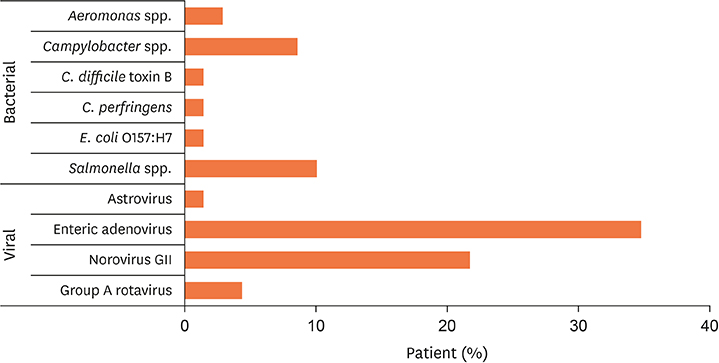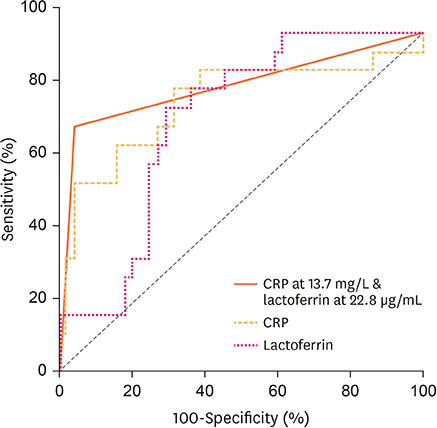Pediatr Gastroenterol Hepatol Nutr.
2019 Jul;22(4):369-376. 10.5223/pghn.2019.22.4.369.
Clinical Significance of Inflammatory Biomarkers in Acute Pediatric Diarrhea
- Affiliations
-
- 1Department of Pediatrics, Incheon St. Mary's Hospital, School of Medicine, The Catholic University of Korea, Incheon, Korea. sykim2010@catholic.ac.kr
- 2Department of Laboratory Medicine, Incheon St. Mary's Hospital, School of Medicine, The Catholic University of Korea, Incheon, Korea. lsok@catholic.ac.kr
- KMID: 2451577
- DOI: http://doi.org/10.5223/pghn.2019.22.4.369
Abstract
- PURPOSE
The aim of this study was to evaluate the clinical significance of inflammatory biomarkers in acute infectious diarrhea among children.
METHODS
Clinical parameters including fever, bacterial and viral etiology based on stool culture and multiplex polymerase chain reaction, and nine biomarkers including C-reactive protein (CRP), erythrocyte sedimentation rate (ESR) and leukocytes in blood and calprotectin, lactoferrin, myeloperoxidase, polymorphonuclear elastase, leukocytes, and occult blood in feces were evaluated in children who were hospitalized due to acute diarrhea without underlying disease.
RESULTS
A total of 62 patients were included. Among these patients, 33 had fever, 18 showed bacterial infections, and 40 patients were infected with 43 viruses. Of all the biomarkers, CRP was significantly correlated with fever (p<0.001). CRP, ESR, calprotectin, lactoferrin, myeloperoxidase, fecal leukocytes, and occult blood were significantly associated with infection with bacterial pathogens (p<0.001, p=0.04, p=0.03, p=0.003, p=0.02, p=0.03, p=0.002, respectively). The combination of CRP and fecal lactoferrin at their best cut-off values (13.7 mg/L and 22.8 µg/mL, respectively) yielded a sensitivity of 72.2%, and a specificity of 95.5% for bacterial etiology compared with their individual use.
CONCLUSION
Blood CRP is a useful diagnostic marker for both fever and bacterial etiology in acute pediatric diarrhea. The combination of CRP and fecal lactoferrin yields better diagnostic capability for bacterial etiology than their use alone for acute diarrhea in children without underlying gastrointestinal disease.
Keyword
MeSH Terms
-
Bacterial Infections
Biomarkers*
Blood Sedimentation
C-Reactive Protein
Child
Diarrhea*
Feces
Fever
Gastrointestinal Diseases
Humans
Lactoferrin
Leukocyte L1 Antigen Complex
Leukocytes
Multiplex Polymerase Chain Reaction
Occult Blood
Pancreatic Elastase
Peroxidase
Sensitivity and Specificity
Biomarkers
C-Reactive Protein
Lactoferrin
Leukocyte L1 Antigen Complex
Pancreatic Elastase
Peroxidase
Figure
Reference
-
1. Lanata CF, Fischer-Walker CL, Olascoaga AC, Torres CX, Aryee MJ, Black RE, et al. Global causes of diarrheal disease mortality in children <5 years of age: a systematic review. PLoS One. 2013; 8:e72788.2. GBD 2013 Mortality and Causes of Death Collaborators. Global, regional, and national age-sex specific all-cause and cause-specific mortality for 240 causes of death, 1990–2013: a systematic analysis for the Global Burden of Disease Study 2013. Lancet. 2015; 385:117–171.3. Thielman NM, Guerrant RL. Clinical practice. Acute infectious diarrhea. N Engl J Med. 2004; 350:38–47.4. Shastri YM, Bergis D, Povse N, Schäfer V, Shastri S, Weindel M, et al. Prospective multicenter study evaluating fecal calprotectin in adult acute bacterial diarrhea. Am J Med. 2008; 121:1099–1106.
Article5. Lee HM, Lee S, Lee BI, Jekarl DW, Song JY, Choi HJ, et al. Clinical significance of fecal lactoferrin and multiplex polymerase chain reaction in patients with acute diarrhea. Gut Liver. 2015; 9:636–640.
Article6. Nudelman R, Kagan BM. C-reactive protein in pediatrics. Adv Pediatr. 1983; 30:517–547.7. Jaye DL, Waites KB. Clinical applications of C-reactive protein in pediatrics. Pediatr Infect Dis J. 1997; 16:735–746.
Article8. Chen CC, Huang JL, Chang CJ, Kong MS. Fecal calprotectin as a correlative marker in clinical severity of infectious diarrhea and usefulness in evaluating bacterial or viral pathogens in children. J Pediatr Gastroenterol Nutr. 2012; 55:541–547.
Article9. Sutherland AD, Gearry RB, Frizelle FA. Review of fecal biomarkers in inflammatory bowel disease. Dis Colon Rectum. 2008; 51:1283–1291.
Article10. Peterson CG, Eklund E, Taha Y, Raab Y, Carlson M. A new method for the quantification of neutrophil and eosinophil cationic proteins in feces: establishment of normal levels and clinical application in patients with inflammatory bowel disease. Am J Gastroenterol. 2002; 97:1755–1762.
Article11. Langhorst J, Elsenbruch S, Koelzer J, Rueffer A, Michalsen A, Dobos GJ. Noninvasive markers in the assessment of intestinal inflammation in inflammatory bowel diseases: performance of fecal lactoferrin, calprotectin, and PMN-elastase, CRP, and clinical indices. Am J Gastroenterol. 2008; 103:162–169.
Article12. Chen CC, Chang CJ, Lin TY, Lai MW, Chao HC, Kong MS. Usefulness of fecal lactoferrin in predicting and monitoring the clinical severity of infectious diarrhea. World J Gastroenterol. 2011; 17:4218–4224.
Article13. Sýkora J, Siala K, Huml M, Varvařovská J, Schwarz J, Pomahačová R. Evaluation of faecal calprotectin as a valuable non-invasive marker in distinguishing gut pathogens in young children with acute gastroenteritis. Acta Paediatr. 2010; 99:1389–1395.
Article14. Lee S, Park YJ, Lee HK, Kim SY, Kim JY, Lee SY, et al. Detection of 13 enteric bacteria and 5 viruses causing acute infectious diarrhea using multiplex PCR from direct stool specimens. Ann Clin Microbiol. 2013; 16:33–38.
Article15. Bardhan PK, Beltinger J, Beltinger RW, Hossain A, Mahalanabis D, Gyr K. Screening of patients with acute infectious diarrhoea: evaluation of clinical features, faecal microscopy, and faecal occult blood testing. Scand J Gastroenterol. 2000; 35:54–60.
Article16. Berger RM, Berger MY, van Steensel-Moll HA, Dzoljic-Danilovic G, Derksen-Lubsen G. A predictive model to estimate the risk of serious bacterial infections in febrile infants. Eur J Pediatr. 1996; 155:468–473.
Article17. Sanders S, Barnett A, Correa-Velez I, Coulthard M, Doust J. Systematic review of the diagnostic accuracy of C-reactive protein to detect bacterial infection in nonhospitalized infants and children with fever. J Pediatr. 2008; 153:570–574.
Article18. Kim DH, Kang SH, Jeong WS, Moon HS, Lee ES, Kim SH, et al. Serum C-reactive protein (CRP) levels in young adults can be used to discriminate between inflammatory and non-inflammatory diarrhea. Dig Dis Sci. 2013; 58:504–508.
Article19. Joishy M, Davies I, Ahmed M, Wassel J, Davies K, Sayers A, et al. Fecal calprotectin and lactoferrin as noninvasive markers of pediatric inflammatory bowel disease. J Pediatr Gastroenterol Nutr. 2009; 48:48–54.
Article20. Pang T, Leach ST, Katz T, Day AS, Ooi CY. Fecal biomarkers of intestinal health and disease in children. Front Pediatr. 2014; 2:6.
Article
- Full Text Links
- Actions
-
Cited
- CITED
-
- Close
- Share
- Similar articles
-
- Acute infectious Diarrhea in Pediatirc Patients
- Acute infectious diarrhea
- Efficacy of Lactobacillus Acidophilus in Treatment of Acute Diarrhea in Children
- The Comparison of Clinical Characteristics in Three Types of Viral Acute Diarrhea in Infants and Toddlers and the Effect of Lactobacillus acidophilus on Rotaviral Diarrhea
- Clinical Significance of Fecal Lactoferrin and Multiplex Polymerase Chain Reaction in Patients with Acute Diarrhea



